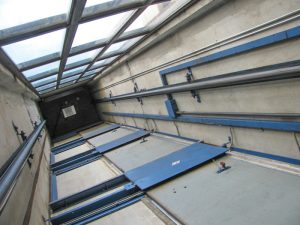— By Charlie Slater —
Consistent elevator & escalator maintenance is helpful to the bottom line.
It’s no secret that elevators and escalators are essential to a building. They provide the building’s occupants safe and efficient vertical transportation to their desired location. With these conveyances being relied on by hundreds — if not thousands — of people in a single building on a given day, their safety is on the line. This means that building owners and facility managers cannot be too cautious when it comes to having their conveyances maintained. In order to deliver the safest system possible to tenants, not to mention protect a large financial investment, proactive elevator and escalator maintenance is critical.

Charlie Slater, ATIS Elevator Inspections
Just as people want to maintain their cars to protect their investment, the same should be done with a building’s conveyances. With a car, there are regular oil changes to make sure the engine runs efficiently and doesn’t get damaged over time. With an elevator and escalator, consistent maintenance is needed as well to protect the equipment and ensure it is running properly. A lack of maintenance will cause some equipment to wear down more quickly over time and lead to premature breakdowns.
The frequency of preventative maintenance required varies based on the type of equipment, the operation environment and requirements that fall under the code. There are code-specified maintenance requirements specified for hydraulic elevators and electric elevators, which most commonly are traction elevators. It is required to make sure these conveyances are kept within code and in safe operating condition.
Consistent equipment maintenance catches potential issues before they manifest themselves into bigger problems that may cause shutdowns. Preventative maintenance ensures that the equipment is kept in good working order. This will better prevent elevators and escalators from having breakdowns that may require additional expenses and time to get them back up and running.
To relate it to maintaining a car again, if the oil is never changed and the engine locks up, that would cause more damage than if the oil had just been changed consistently. With an elevator, there are several tasks that are performed that keep the equipment clean, lubricated and adjusted so that the equipment doesn’t bind up. Also trash or additional buildup on the equipment can cause damage, leading to unexpected shutdown.
 Most building owners have their elevators on a maintenance agreement and are required by the American Society of Mechanical Engineers’ A17.1 Safety Code for Elevators and Escalators to have a Maintenance Control Program (MCP) provided by an elevator maintenance company. Unfortunately, when owners look at the cost of preventative maintenance, they tend to focus at the short term costs. In some situations, they only look at what the maintenance agreement is going to cost them either monthly, quarterly or annually. Instead, they should look at what it’s going to cost them if there is a major repair due to lack of maintenance. Repairs are costly not only in parts and labor, but also in the lost usage of the building’s elevating equipment. A few extra dollars a month could save tens of thousands of dollars in repair or replacement costs per conveyance.
Most building owners have their elevators on a maintenance agreement and are required by the American Society of Mechanical Engineers’ A17.1 Safety Code for Elevators and Escalators to have a Maintenance Control Program (MCP) provided by an elevator maintenance company. Unfortunately, when owners look at the cost of preventative maintenance, they tend to focus at the short term costs. In some situations, they only look at what the maintenance agreement is going to cost them either monthly, quarterly or annually. Instead, they should look at what it’s going to cost them if there is a major repair due to lack of maintenance. Repairs are costly not only in parts and labor, but also in the lost usage of the building’s elevating equipment. A few extra dollars a month could save tens of thousands of dollars in repair or replacement costs per conveyance.
As a building owner, it’s difficult to know whether the maintenance company’s MCP is sufficient.
The more elevators are used, the more maintenance tasks need to be performed. Just like the more a car is driven, the more often it needs oil changes. That’s where elevator inspections come in. They are required by the jurisdiction to ensure elevators are being maintained to code and safety standards, which will prevent downtime and prolong equipment life.
Unfortunately, many building owners simply do not know enough about the equipment and what goes into the maintenance in order to choose the MCP that works best for them.
Typically, when an owner or facility manager enters a maintenance agreement, they pay for the maintenance whether it is performed or not. There are contracts that require certain maintenance be performed on a regular basis. Those contracts require a specific maintenance activity be performed at a certain frequency or for a set number of hours per month.
If the maintenance company has provided an MCP tailored to that elevator based on the specific conditions, such as the equipment’s age, type of equipment and usage environment, among others, that elevator will be properly maintained. However, this is rare as very few units have an MCP in place that is tailored to the elevator or has a consistent schedule being followed. The MCP may specify a particular maintenance task, but the elevator company is not always able to visit the elevator frequently enough to perform the task. Therefore, the task does not get performed based on the needed frequency.
The program may be so general that the frequency is only once a year or every 18 months. This makes it very easy for the maintenance company to adhere to the program, but it is not meeting the needs of the equipment. There are agreements where owners will pay for maintenance every month for a year, but the elevator company will only see the elevator once a year. This is usually just to perform testing on the equipment as it’s required by the jurisdiction.
 When it comes to escalators, there is a rarely enforced requirement that a trained building representative must complete a startup checklist daily or every time the escalator is turned on to ensure the unit is in safe operational condition. The building’s elevator maintenance company or inspection company can provide guidance on what should be performed during the check and can even offer training if needed. The building owner or facility’s maintenance staff should do this to verify each escalator is safe and in good working order. If issues are found, they should be brought to the elevator maintenance company’s attention.
When it comes to escalators, there is a rarely enforced requirement that a trained building representative must complete a startup checklist daily or every time the escalator is turned on to ensure the unit is in safe operational condition. The building’s elevator maintenance company or inspection company can provide guidance on what should be performed during the check and can even offer training if needed. The building owner or facility’s maintenance staff should do this to verify each escalator is safe and in good working order. If issues are found, they should be brought to the elevator maintenance company’s attention.
Also, once a year, a clean down should be performed on each escalator. Clean downs ensure all parts are free of debris, properly lubricated and adjusted, which helps prevent shutdowns and damage to the equipment. Annual clean downs used to be standard practice but are no longer included in many maintenance agreements. The process of a clean down is lengthy due to most, if not all, of the steps needing to be removed and could take 2 or more days to complete. Buildings are often concerned about shutting down escalators for that long, and mechanics struggle with making the time for such work due to their schedules.
In the end, it saves money for building owners or facility managers to follow through on maintenance agreements, and it is crucial to make sure the maintenance companies are following through on these plans. The MCP is intended to perform preventative maintenance to ensure they are code compliant and in safe operating condition. It also prolongs equipment life, which saves money for the building owner in the long run. If building owners take an active role in their maintenance program or MCP, they can ensure their units are kept safe and reliable, protecting their investment.
— Frederick “Charlie” Slater is the director of field operations for ATIS Elevator Inspections, where he oversees all Qualified Elevator Inspectors (QEI) across the U.S. from his office in New Port Richey, Florida. Based in St. Louis, ATIS Elevator Inspections, a wholly-owned subsidiary, is the largest U.S.-owned elevator inspection company, providing third-party safety inspection and test witnessing services for elevators, escalators, moving walks and other conveyances.
